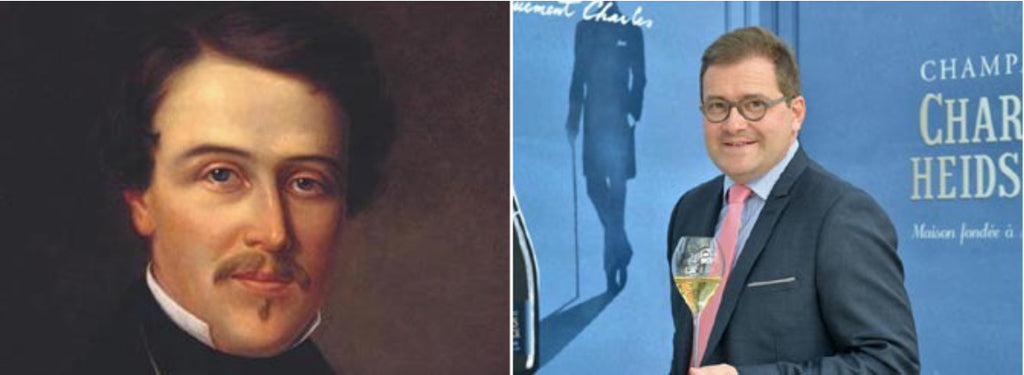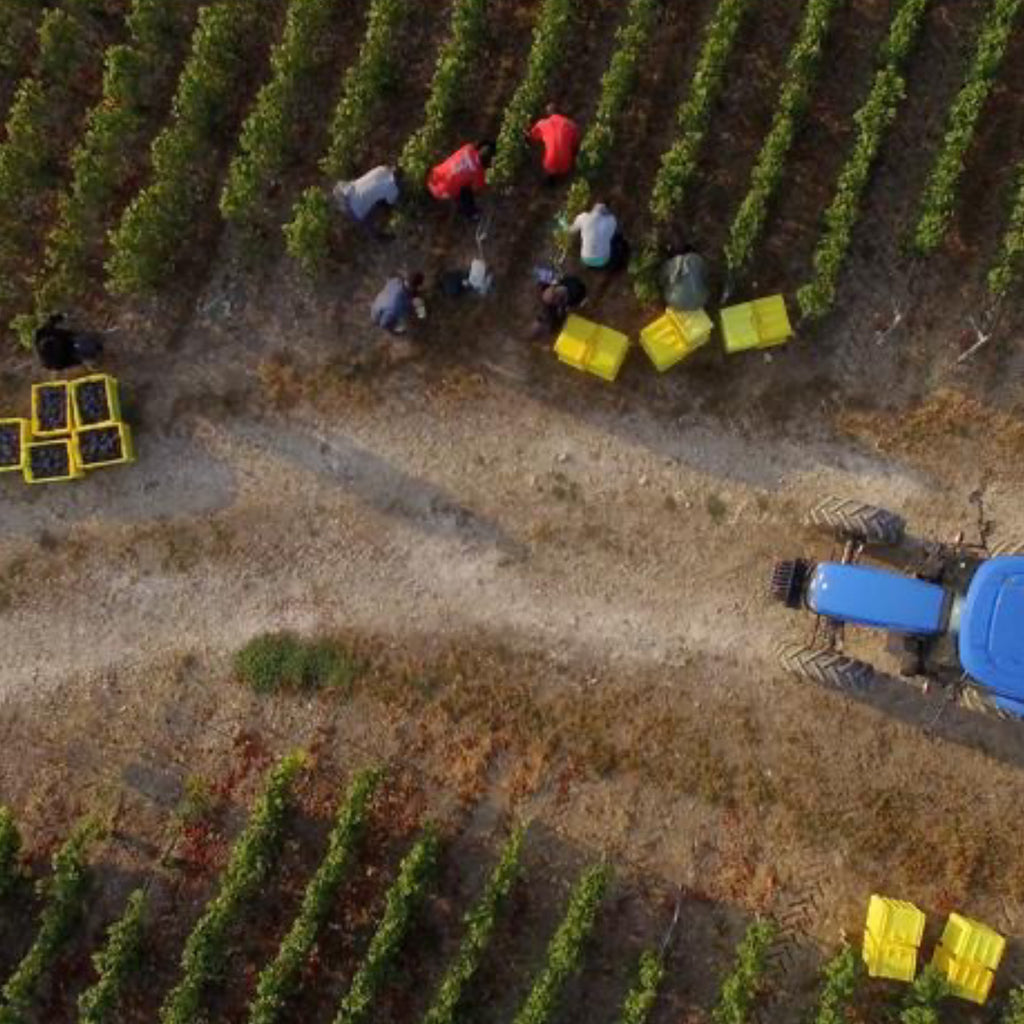Probably the most consistent Champagne House today, still family run and delivering remarkable quality and style – so much so that the House has been awarded the IWC Trophy for “Sparkling Winemaker of the Year” an unrivalled 14 times in the last 25 years.
“I don’t think any acclaim this house has received has ever been sufficient. After more than 30 years intensive experience and a great deal of mature reflection, I have ripped up my old list of Champagne’s greatest producers and started afresh with Charles Heidsieck firmly at the top. There are other great producers, but none that can match the consistency of Charles Heidsieck cuvée for cuvée, from the basic non-vintage through vintage to prestige cuvée. Every single Champagne in the Charles Heidsieck range is stunning. There are no duds, not even slight disappointments.” – Tom Stevenson (highly regarded Champagne critic and wine writer)

Founder – 1851 - Charles Heidsieck (“Champagne Charlie”) and for the last 7 years Chef de Caves Cyril Brun
Much like the Champagne, the awards keep flowing…
Charles Heidsieck is today one of the greatest names in Champagne and produces some of the finest wines across a wide range. Founded in 1851 by Charles-Camille Heidsieck, the original ‘Champagne Charlie’, the foundation of its modern fame rests on the unrivalled quality of its wines - which receive countless awards and accolades year after year. However, it was not always like this.
After a period of relative decline, this modern success is attributable to the strength and depth of their winemaking team over the past three decades: the legendary Daniel Thibault, (who passed away far too young in 2002), then Régis Camus, Thierry Roset and Cyril Brun (from 2015). Cyril has just passed the baton to the new Chef des Caves Elise Losfelt. Between them all, they have been awarded ‘Sparkling Winemaker of the Year’ at the International Wine Challenge 14 times. No other house has won this accolade more than twice.
A Champagne trailblazer

Not to be confused these days with their fellow Champagne houses Piper Heidsieck and Heidsieck and Co. Monopole - although they do, in fact, share common origins. In 1785, Florens-Louis Heidsieck founded a cloth and wine company under the Heidsieck and Co. name, and from there the other family franchises set sail.
At 29 years of age, a young Charles Heidsieck took it upon himself to establish his own Champagne house in 1851 and, much like his great-uncle, he enjoyed a burgeoning reputation in his homeland. However, he didn’t simply stop there…
Merely a year later, Charles journeyed across the Atlantic to bring Champagne to the virgin soils of the US. He extensively toured the Northeast coast in the hope that the sparkling beverage would be a success in the American market. And it certainly was. In 1857, over 300,000 bottles were sold – more than in is sold in the UK today. Following his travels, Charles Heidsieck had become a celebrity with widespread newspaper coverage amongst the banquet receptions of New York’s high society, and he then became widely recognised as “Champagne Charlie” (It is also worth noting that, in those days, Champagne's in general were much sweeter than today).
Such fortunes did not last, unfortunately, and were brought to an abrupt end by the outbreak of Civil War. With unpaid accounts in the US, and cheated by his New York agent, Charles was forced to travel to the south of the country to pursue payment from the merchants directly. Despite travelling undercover, Charles inevitably ran into trouble with the Union Army.
Upon arrival, he found the merchants to be virtually bankrupt and unable to pay their debts to him financially. Alternatively, he accepted cotton as repayment as it was in high demand back in Europe. After an unsuccessful attempt to get shipments past Union blockades, Charles fashioned an escape plan after finding his routes back to the North sealed by unionist forces. While attempting to reach Mexico or Cuba, he was seized upon in New Orleans. From celebrity to “criminal”, he was imprisoned after being charged with spying – for which he pleaded innocent. He was eventually released by President Lincoln in 1862 and returned to France. Broke and, at the time, broken.
However, Charles’s life took another dramatic turn. The brother of his New York agent contacted him, lending him the deeds to some land in Colorado as a form of apology - and to settle their differences. As it turned out his newly owned land became extremely valuable, owing to the expansion of the American West and the ensuing development of Denver - a centre for wealth and post-war prosperity.
Debts repaid and accounts replenished, Charles was able to revitalise his Champagne house and re-establish himself as one of France’s most premium Champagne producers. Even after Charles’ death, the American market continued to flourish. During the time of prohibition, ironically, business began to boom once more. In 1929, over three quarters of a million Champagne bottles were sold – with the Wall Street crash to boot!
Business is still going strong
Charles Heidsieck died in 1893 and his descendants (all called Charles in turn) continued to run the House until the company was taken over by the Descours family in 2011. Their commitment to the House has seen substantial levels of investments and long-term planning, with the total focus being on quality as the bedrock of all production and sales activities.
 Charles Heidsieck’s atmospheric 2nd century chalk cellars – or Crayères – spookily in the shape of a bottle of Charles Heidsieck.
Charles Heidsieck’s atmospheric 2nd century chalk cellars – or Crayères – spookily in the shape of a bottle of Charles Heidsieck.
The real turning point for the House had come a few years earlier. The modern history of Charles Heidsieck owes much to the single-minded dedication of former Chef de Caves Daniel Thibault, who from the late 1980s until his untimely death in 2002, totally transformed the quality and image of the whole range of Champagnes, and then established the formidable blueprint that the House has so religiously stuck with to this day.
Alongside their 173 acres of homegrown varieties, Charles Heidsieck also buy grapes from 120 different vineyards. With such a wide scope in the region to select fruit, this Champagne House has unrivalled access to the best vineyards and the most incredible collection of reserve wine in Champagne. It is the blending of these different “terroirs” that is invariably the key to their top quality Champagne.
The winemaking philosophy and approach is simple and very effective. It is evident, most importantly, in the Brut Réserve NV. Grapes are regularly sourced from 60 different ‘crus’ (Villages and Varieties) across the region. The fermentation and the ageing of the base wines take place primarily in stainless steel to preserve freshness, and is usually composed of roughly a third of each of the Champagne grape varieties - Chardonnay, Pinot Noir and Meunier. But incredibly, they also include up to 40% reserve wines (older, finer wines that are held back for use in the blending to create that fabulous House style year on year) with the average age of at least 10 years.
The Brut Réserve is aged in bottle on its lees for at least three years prior to release. The components that derive from this process combine to give a wine that is more “Premier Cru” than simply a “Brut Réserve” - and this maybe accounts for some of its success at the internationally recognised wine competitions. A much richer non vintage style than most Champagnes on the market – beautifully honeyed notes and real texture with fantastic length and pedigree. The demand for this wine is so strong that it has quite often needed to be allocated in the UK market.

Nice aerial shot of harvest time in the Charles Heidsieck vineyards
The Rosé Réserve Brut NV is quite pale in colour and delicately scented on the nose. The 4-5% of red wine in the blend comes exclusively from Les Riceys, in the Côte des Bar, whose Pinot Noirs are full of flavour while being low in tannin. This is quite a rich style of Rosé with bright red berry fruit – it works well with lighter food dishes.
The 2012 Brut Millésimé is a fabulous vintage year - one of the top 3 vintages since the turn of the millennium. It exhibits all the hallmarks of the House - fresh acidity, richness, elegance, and length. This is an outstanding wine which can be enjoyed now or cellared for up to 10 years.
In 2018, the House released a Blanc de Blancs Non-Vintage - for the first time in almost half a century. Made exclusively from Chardonnay (50% from the Côte des Blancs, 25% from the Montagne de Reims and 25% from Montgueux), with 25% of reserve wine, its freshness is balanced by its structure, richness, and velvety texture - perfectly embodying the recognisable “Charles style”.
Charles Heidsieck’s Blanc des Millénaires is the Blanc de Blancs masterpiece of the House. Only seven vintages of this rare Cuvée have been produced (1983,1985,1990,1995, 2004, 2006, and, the current release, 2007). Made from the best Chardonnay from the Côte des Blancs (Cramant, Avize, Oger, Le Mesnil-sur-Oger and Vertus), this is an elegant and distinctive Blanc de Blancs. The 2007 is a fabulous vintage showcasing saline minerality and exceptional texture that is the hallmark of all the Blanc des Millénaires. This cuvée balances bright acidity and citrus character with gentle toasted, smoky notes. Both fresh and generous on the palate, the silky, creamy texture follows through to a remarkably complex and persistent finish. Blanc des Millénaires 2007 carries all the vivacity, maturity, and exceptional ageing potential of an outstanding vintage. Perfectly mature now but with plenty in the tank to age and evolve for years to come.
In 2022, to celebrate the 200th Anniversary of the birth of Charles Camille Heidsieck, Charles Heidsieck relaunched the legendary Cuvée Champagne Charlie. Paying tribute to the original Cuvée Charlie released only five times (1979, 1981, 1982, 1983 and 1985), the “new Charlie” is the ultimate expression of the Charles Heidsieck House style. Revealed by the Chef de Cave, Cyril Brun, the Cuvée Charlie, cellared in 2017, is a blend of 80% of some of the best reserve wines of the House collection (48% Pinot Noir and 52% Chardonnay going back to 1998), topped up with 20% of 2016 Grand Cru Pinot Noir from Aÿ.
It has notes of grapefruit and roasted pineapple enlivened with the vivacity of toasted, mineral notes. After time, aromas of fresh fruits (apricots, vineyard peaches) give way to persistent notes of pastry. To quote the House, “The texture is truly the soul of Charlie, where we find that paradox of juvenile freshness and fleshiness, with a silkiness fitting of a more mature wine. This “dry fleshiness” is enhanced with a highly nuanced effervescence, composed of extremely harmonious bubbles. The finish reveals candied citrus and the exotic notes of passion fruit”. A fine testament to a true pioneer.


Nick says, “I am looking forward to working even more closely with Jake and the team at Vino Gusto. I hope to bring my broad trade experience into play to keep you informed and entertained via these monthly blog releases. Please do though let us know of any subject matters which might be of special interest to you, and we will see if can get these included over the coming months”.


















Leave a comment